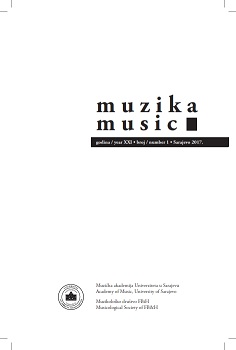O Petru Peloponeskom i muzičkim prožimanjima naroda na Balkanu u 18. veku
About Petros Peloponnesios and musical relationships of the Balkan nations
Author(s): Vesna Sara PenoSubject(s): Cultural history, Music, History of Church(es), Sociology of Culture, 18th Century, Eastern Orthodoxy, Sociology of Religion
Published by: Univerzitet u Sarajevu - Muzička akademija; Muzikološko društvo FBiH
Keywords: Petros Peloponnesios; Bosnian Orthodox Metropolitan Serafim; Yale fragment; church and world music; Balkans;
Summary/Abstract: Greek musician Petros Peloponnesios is known to have lived in the third quarter of the 18th century. He had the title of Lampadarios - chanter in the left choir of the Great Church in Constantinople and was also one of the chanting teachers in the music school founded in 1776 by the Sophronius the Second - Patriarch of Constantinople. The name of this prolific composer and reformer of the late-Byzantine neum notation may be found in a substantial number of neum manuscripts of the late eighteenth century, as well as in the published chanting books from the first decades of the nineteenth century onwards. He is also reported to have had close music relations with the Melvevi Dervishes in Constantinople. Recent research has showed that he composed about hundred secular songs using Greek text, late-Byzantine music notation and Ottoman makam.The socalled Yale musical fragment –eleven sheets with neum notation from the collection consisting of four different parts, which was discovered in the library of old and rare books at Yale University by musicologist Miloš Velimirović, confirmed the correlation of Petros Peloponnesios with Balkan Slavs. According to the inscription of the said fragment “the most learned musician, Kyr Petros Lampadarios of Peloponnese” has adopted melodies from the “old Anastasimatarion, at the request of the Very Reverend and Holy Metropolitan of Bosnia, Kyr Seraphim, for the use of the Slavs…” The melodies of the thirteen stichera of Mode I of the Octoëchos (in Greek Anastasimatarion) were set in Church-Slavonic in such a way that scribe used Greek letters for Slavonic words. The fragment contains also the melismatic hymn in honour of St. Dionysios of Olympos in Greek of the Mode IV. Velimirović in cooperation with other Serbian musicologist Dimitrije Stefanović published in 1966 the first and so far the only scientific article on Yale fragment. New insight into this rare and important source for Church-chant tradition of the Balkan Slavs has provided an updated and corrected data, but also imposed new issues which need to be resolved in future research. There are two key conclusions that have been reached in a re-analysis of Yale fragment. Music model that Petros Peloponnesios used for the adaptation of the stichera melodies to the Church Slavonic text was not the version of Manuel Doukas Chrysaphes, the most prominent Byzantine musician of the 15th century, as D. Stefanović claimed, but his younger namesake Panagiotes the new Chrysaphes whose main approach was based on the recomposition of the late medieval sticherarion as it was described by Manuel Chrysaphes in his famous treatise about psaltic art. Chrysaphes the New made also a so called kalophonic recomposition of the simple psalmody of the Byzantine Octoechos – Anastasimatarion which was used in church services under the name “old Anastasimatarion”.A precise attribution of the Yale fragment was carried out for the first time. It was found that its scribe was not actually Petros Peloponnesios (as suggested in Velimirović and Stefanović’s article), but Petros Byzantios, Peloponnesios’s younger contemporary and disciple. Based on recently conducted historical research, the paper presented the new findings in connection with the Bosnian Metropolitan Seraphim, who was originally a Bulgarian and was bound for Bulgarian Rila Monastery.
Journal: Časopis za muzičku kulturu Muzika
- Issue Year: XXI/2017
- Issue No: 1
- Page Range: 44-60
- Page Count: 17
- Language: Serbian

